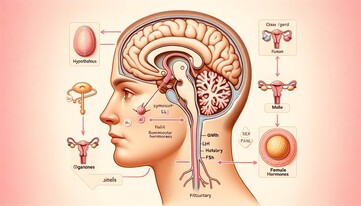Gonadotropin-Releasing Hormone (GnRH) is a critical hormone produced in the hypothalamus, acting as a key regulator of the endocrine system’s control over human reproduction. It signals the pituitary gland to release two vital hormones, luteinizing hormone (LH) and follicle-stimulating hormone (FSH), which are essential for the functioning of the reproductive organs – the ovaries in females and the testes in males.
Understanding GnRH’s Role in Reproductive Health
GnRH is known by several alternative names, such as Luteinizing Hormone-Releasing Hormone (LHRH) and Follicle-Stimulating Hormone-Releasing Hormone (FSHRH), reflecting its central role in managing reproductive hormone activities. The synthetic form of GnRH, known as Gonadorelin, is used in various medical treatments.
Distinctly, GnRH exists in two forms: GnRH-1, the primary variant responsible for regulating the menstrual cycle and spermatogenesis via a pulsatile release mechanism, and GnRH-2, a more recently discovered form with a presence in tissues like the placenta and gastrointestinal tract, indicating a wider range of functions.
GnRH Analogues’ Critical Function in IVF
In the realm of In Vitro Fertilization (IVF), GnRH analogues, including both agonists and antagonists, play a crucial role. Agonists such as leuprolide and goserelin initially boost then suppress the pituitary gland’s activity to avert early ovulation, enhancing follicle development for IVF. Conversely, antagonists like cetrorelix and ganirelix block GnRH’s action outright, allowing for precise ovulation control.
Why GnRH Analogues are Indispensable in IVF
THE APPLICATION OF GNRH ANALOGUES IS FUNDAMENTAL IN IVF FOR VARIOUS REASONS:
Follicular Synchronization: They ensure the simultaneous development of multiple follicles, raising the success rate of egg retrieval.
Preventing Premature Ovulation: By avoiding early egg release, these analogues are key to the IVF cycle’s effectiveness.
Controlled Ovulation Timing: They enable the exact timing for egg retrieval, optimizing the chance to collect viable eggs.
Hormonal Balance: The analogues keep hormonal levels favorable for egg maturation and the induction of ovulation.
The Distinction Between GnRH Agonists and Antagonists
In IVF treatments, GnRH analogues are categorized into agonists, which initially stimulate but eventually dampen pituitary gland responses, and antagonists, which directly inhibit GnRH’s action for immediate ovulation control. This distinction allows for tailored approaches in IVF protocols, enhancing their effectiveness.
The Broader Impact of GnRH and Its Analogues
Direct GnRH level measurement is challenging due to its pulsatile secretion; thus, indirect indicators like LH and FSH levels are typically used. Variations in GnRH levels can signify reproductive issues, including menstrual irregularities and fertility problems in women, and conditions like hypogonadism in men.
In the context of fertility treatments, the use of GnRH analogues can also facilitate procedures involving sperm donors by synchronizing the recipient’s cycle with the donor sperm availability, thereby enhancing the success rates of such interventions.
In essence, GnRH and its analogues are foundational to both reproductive health management and the advancement of assisted reproductive technologies such as IVF. Through strategic manipulation of this hormone, healthcare professionals can optimize fertility treatments, address reproductive health issues, and support the family-building aspirations of individuals and couples.


